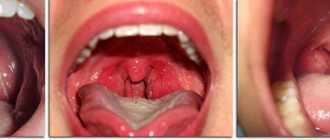Symptoms:
- red, swollen tonsils with white or yellowish coating or streaks;
- a sore throat;
- difficult and/or painful to swallow;
- fever (temperature above 38.0);
- cervical lymph nodes are enlarged;
- hoarse or hoarse voice;
- headache;
- stiff neck muscles;
- abdominal pain (especially in young children).
In infants:
- drooling due to pain in swallowing;
- anxiety;
- refusal to eat
- With chronic tonsillitis, your breath may smell bad.
Why do you need to rinse your tonsils?
The palatine tonsils are an organ of the human immune system. They are located at the very entrance to the pharynx on both sides. Outwardly, they resemble almonds. This similarity gave this organ its name. The tonsils consist of a large number of winding canals - crypts. On the surface of the tonsils there are small depressions - lacunae. It is in them that tonsillitis plugs accumulate, which are removed by washing.
Our tonsils act like a filter. They filter everything that enters the oral cavity from outside. And if infectious flora gets on the surface of the tonsils, they begin to produce lymphocytes - cells of the immune system that begin to fight the “enemy”.
If the body's defenses are not enough to cope with viruses and bacteria, an inflammatory process (chronic tonsillitis) starts in the palatine tonsils. In the gaps, pathogenic microflora is activated, the remains of bacterial activity and dead leukocytes accumulate. This entire “mixture” is compressed and turns into white-yellow plugs on the tonsils, which are noticeable upon examination and emit an unpleasant odor. These plugs do not allow inflammation to subside, so sanitation of the tonsils is an important part of the treatment of chronic tonsillitis.
Often, rinsing is the only way to preserve the tonsils and avoid their removal.
Complications of tonsillitis
- Labored breathing.
- Sleep apnea (holding your breath during sleep).
- Spread of infection to the tissue near the tonsils (peritonsillitis), peritonsillar abscess - accumulation of pus behind the tonsil.
- Acute cervical lymphadenitis is inflammation of the cervical lymph nodes.
Streptococcal tonsillitis can cause complications such as:
- acute rheumatic fever, affecting the joints, heart and other organs;
- glomerulonephritis (inflammation of the kidneys, which can lead to serious consequences, including kidney failure).
Treatment with antibiotics significantly reduces the likelihood of complications after streptococcal sore throat.
How to clean tonsils
You can minimize the side effects of tonsillitis by regularly doing preventive rinsing of your tonsils at home. To do this, you need to take a syringe (10 ml) without a needle or a small syringe with a soft, long tip. The procedure is carried out in front of a mirror. You need to keep your head straight to control the direction of the jet in the reflection of the mirror. When irrigating, they hold their breath. Tonsils need to be treated closer to the lacunae. Washing is carried out in stages:
- The mouth is rinsed with boiled water or herbal decoction.
- Draw an antiseptic into a syringe (syringe).
- The lacunae are treated with liquid pressure.
- The mouth is rinsed with an antiseptic.
The tonsils are washed from pus up to 5 times a day, always after each meal. The procedure can be carried out using an irrigator using a standard nozzle. To do this, a minimum pressure level is set on it. The tonsils are washed one by one.
Since the liquid washes out pathogenic bacteria from the ducts, it must be constantly spat out. Otherwise, the infection gets inside, which can cause inflammation in the larynx, lungs, and bronchi. For such actions to be effective, it is important to maintain a water regime, as well as take additional medications prescribed by the doctor.
Diagnosis of tonsillitis
- For tonsillitis, the doctor will examine the child's throat, as well as his ears and nose, where there may also be inflammation.
- The doctor will examine the child's skin, since streptococcal sore throat sometimes causes a specific rash. This is what is called “scarlet fever” - it is not some kind of separate disease, but a sign of damage to the body by streptococcus.
- The doctor will feel the cervical lymph nodes - as a rule, with tonsillitis they swell.
- The doctor will feel the spleen to distinguish a sore throat from mononucleosis, which also causes swollen lymph nodes.
- The streptococcal test is a simple and accurate way to distinguish streptococcal tonsillitis from viral tonsillitis. The doctor takes a scraping from the child’s throat and within 24-48 hours the result is ready.
- In some cases, a general blood test may be needed, the results of which can also indicate the viral or bacterial nature of the disease. It is usually taken if the streptococcal test is negative, but the course of the disease leaves the doctor in doubt.
About the clinic
Euromed Clinic is a multidisciplinary family clinic in the center of St. Petersburg.
- Calling a doctor to your home
- 24/7 therapist appointment
- Tests, ultrasound, x-ray
- Whole body diagnostics
- Hospital and surgery
- Vaccination
Find out more about the clinic
Rinsing the tonsils with a syringe
This method is the most common and accessible. It will be offered to you at the local clinic. The essence of the technique is as follows: an ENT doctor, using a needle-free syringe, injects an antiseptic drug into the lacunae of the tonsils, which, together with the purulent masses from the lacunae, is washed into the patient’s oral cavity. The patient spits the solution into a special tray, and the ENT doctor repeats the procedure. Upon completion, the tonsils are lubricated with Lugol's solution.
The disadvantage of the procedure is that it is not possible to thoroughly rinse the lacunae, since the openings in the tonsils are very narrow. This rinsing helps with minor purulent accumulations.
The manipulation should be carried out by an experienced ENT doctor. Inept movements can injure the walls of the tonsils, which will only worsen the patient’s condition.
Recently, in modern ENT clinics this technique is used less and less, mainly in cases where the patient has a pronounced gag reflex.
It is much more effective to rinse the tonsils using a vacuum method using the Tonsillor apparatus.
Treatment of tonsillitis
The child should be provided with:
- peace and the opportunity to sleep as much as he wants;
- Drink plenty of fluids to relieve sore throats and prevent dehydration;
- air humidification;
- a sore throat can be relieved by both warm drinks and cold ice cream, especially popsicles;
- for a sore throat, it helps to gargle with a solution of table salt and soda - a teaspoon of salt and a small pinch of soda per 250 ml of warm water;
- Children over 4 years old can be offered lozenges for sore throats. Do not give candy to small children - they may choke;
- do not smoke when your child is sick, avoid strong odors that irritate the throat;
- A sore throat and fever can be relieved by medications containing paracetamol and ibuprofen. Don't give children aspirin; in rare cases, it can cause deadly Reye's syndrome.
Confirmed bacterial tonsillitis (usually streptococcal tonsillitis) is treated with antibiotics. It is dangerous to interrupt or stop the course because it increases the likelihood of infection spreading to the joints, heart, kidneys and other organs. Continue taking antibiotics even if your symptoms are completely gone.
Flushing with a syringe
This method can be offered in any clinic. It is considered painless and lasts about 10 minutes. The patient is seated and asked to open his mouth. A cannula is attached to the syringe. The surface of the pharynx is treated with a solution of local anesthetic. They do this to reduce discomfort during manipulation.
After this, the cannula of the syringe is inserted into the cavities of the tonsils and their contents are sucked out. This can be pus, microorganisms and their metabolic products, food debris, or liquid. After the procedure, the surface is irrigated with anti-inflammatory solutions.
Contraindications to washing with hardware methods
Despite such a positive effect from hardware methods, in some cases this method cannot be used. These include:
- Retinal detachment.
- Hypertension in stage 3 or 2B.
- 1st and third trimester of pregnancy.
- Acute forms of infectious diseases.
- Oncopathology.
- Atherosclerosis of coronary or cerebral vessels.
- Active tuberculosis.
- Disorders of the autonomic nervous system.
- Pathology of the respiratory and cardiovascular systems in the stage of decompensation.
How is the procedure performed?
The procedure for washing the tonsils is practically painless, but can still cause a gag reflex. To prevent this from happening, you need to apply a solution of lidocaine, which has a freezing effect, to the tonsils in advance. Next, washing should be carried out in several steps:
- A nozzle is placed on the inflamed tonsil and the Tonsillor vacuum mode is started. The pus is pumped out.
- The vacuum effect created by the device allows you to achieve deep cleansing, which does not happen with simple suction with a syringe.
- After pumping out the pus, a special solution is applied to the tonsils for the best result.
- Then, through special tubes, a medicinal solution is pumped into the tonsils using ultrasound. So, the treatment of inflammation occurs from the inside.
Reference. There are contraindications: cardiovascular diseases, diabetes and others.
Vacuum rinsing of tonsils
Modern otolaryngological offices carry out rinsing of the tonsils with Tonsilor - a special device that carries out cleaning using ultrasound and antiseptic solutions.
It quickly helps to achieve the desired result and has the following effect after use:
- anesthetic;
- antibacterial and antifungal;
- increases local immunity;
- restores normal microflora on the surface of the tonsils.
Prevention of exacerbation of chronic tonsillitis
Prevention of tonsillitis is a set of measures that protect the body from attacks by streptococci in a completely healthy body. First of all, prevention includes strengthening the immune system:
- Hardening. In order for the body to be resistant to temperature changes, it is necessary to harden. In the summer in the fresh air, in the winter you can do it in the bathroom.
- Balanced diet. The menu should include cereals, meat (preferably rabbit or beef), fish, vegetables, and fruits.
- Sports activities. It helps keep you in shape through physical exercise.
- Maintain oral hygiene, brush your teeth with toothpaste in the morning and evening, limit the amount of sweets to prevent caries and other diseases.
- Treat a sore throat in a timely manner. It is enough to consult a doctor in time and follow all his recommendations.
- After the next relapse, in order to avoid a recurrence of exacerbation, you need to visit an otolaryngologist from time to time for prevention.
Help: Proper treatment of sore throat guarantees one hundred percent protection against chronic tonsillitis.
According to statistics, washing the tonsils with Tonsillor helps achieve greater effectiveness in treating the disease compared to other methods. Some patients have reduced relapses, while others note an improvement in their overall health.
What is the Tonsillor device?
"Tonsillor - 3MM" is used for the conservative and surgical treatment of diseases of the ENT organs through the combined effects of ultrasound, vacuum and ozone/NO-containing medicinal substances on the affected tissues.
Ultrasound, which has healing properties, allows for anti-inflammatory and resorption therapy, pain relief, improves blood microcirculation at the site of exposure, cleans wounds of necrotic tissue and bacterial contamination and creates a drug depot at the site of the lesion. Under the influence of ultrasound, trophism, blood supply to tissues, metabolism improve, and local immunity is stimulated.
Washing tonsils at home
If you have tonsillitis, you can rinse your tonsils at home. Someone close to you can help you with this, or do everything yourself. To begin, prepare a saline or furatsilin solution and thick cotton swabs. Soak the latter well with the resulting liquid and then wash the affected lacunae with light pressure. Repeat the action several times.
Those who know the exact location of the organ can manipulate it using a syringe. The needle is then removed. To use this method, you need to have certain skills.










